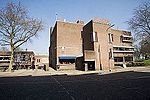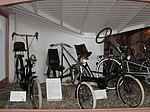St Peter Canisius Church, Nijmegen
20th-century Roman Catholic church buildings in the NetherlandsBuildings and structures in NijmegenChurches in GelderlandJesuit churches in the NetherlandsRoman Catholic churches completed in 1960 ... and 2 more
Roman Catholic churches in the NetherlandsTowers in Gelderland

St Peter Canisius Church (Dutch, Sint-Petrus Canisiuskerk) is a Roman Catholic Parish church in Nijmegen, Gelderland, Netherlands. It is situated on Molenstraat in the centre of the city. It is run by the Society of Jesus and is in the Diocese of 's-Hertogenbosch. It is built on the site of a 14th-century monastery, which was passed into the hands of the Jesuits in 1818. It was rebuilt in 1896 and again in 1960 after being bombed in the Second World War.
Excerpt from the Wikipedia article St Peter Canisius Church, Nijmegen (License: CC BY-SA 3.0, Authors, Images).St Peter Canisius Church, Nijmegen
Ziekerstraat, Nijmegen Nijmegen-Centrum (Nijmegen)
Geographical coordinates (GPS) Address Nearby Places Show on map
Geographical coordinates (GPS)
| Latitude | Longitude |
|---|---|
| N 51.844836 ° | E 5.86319 ° |
Address
Sint-Petrus Canisius
Ziekerstraat
6511 LD Nijmegen, Nijmegen-Centrum (Nijmegen)
Gelderland, Netherlands
Open on Google Maps










